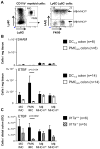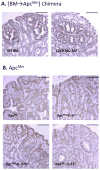Bacteroides fragilis Toxin Coordinates a Pro-carcinogenic Inflammatory Cascade via Targeting of Colonic Epithelial Cells
- PMID: 29398651
- PMCID: PMC5954996
- DOI: 10.1016/j.chom.2018.01.007
Bacteroides fragilis Toxin Coordinates a Pro-carcinogenic Inflammatory Cascade via Targeting of Colonic Epithelial Cells
Erratum in
-
Bacteroides fragilis Toxin Coordinates a Pro-carcinogenic Inflammatory Cascade via Targeting of Colonic Epithelial Cells.Cell Host Microbe. 2018 Mar 14;23(3):421. doi: 10.1016/j.chom.2018.02.004. Cell Host Microbe. 2018. PMID: 29544099 Free PMC article. No abstract available.
Abstract
Pro-carcinogenic bacteria have the potential to initiate and/or promote colon cancer, in part via immune mechanisms that are incompletely understood. Using ApcMin mice colonized with the human pathobiont enterotoxigenic Bacteroides fragilis (ETBF) as a model of microbe-induced colon tumorigenesis, we show that the Bacteroides fragilis toxin (BFT) triggers a pro-carcinogenic, multi-step inflammatory cascade requiring IL-17R, NF-κB, and Stat3 signaling in colonic epithelial cells (CECs). Although necessary, Stat3 activation in CECs is not sufficient to trigger ETBF colon tumorigenesis. Notably, IL-17-dependent NF-κB activation in CECs induces a proximal to distal mucosal gradient of C-X-C chemokines, including CXCL1, that mediates the recruitment of CXCR2-expressing polymorphonuclear immature myeloid cells with parallel onset of ETBF-mediated distal colon tumorigenesis. Thus, BFT induces a pro-carcinogenic signaling relay from the CEC to a mucosal Th17 response that results in selective NF-κB activation in distal colon CECs, which collectively triggers myeloid-cell-dependent distal colon tumorigenesis.
Keywords: Nf-κB; STAT-3; colorectal cancer; inflammation; mucosal immunology; myeloid cells.
Copyright © 2018 Elsevier Inc. All rights reserved.
Conflict of interest statement
The authors declare no competing interests
Figures







Comment in
-
Pancreatic cancer: KRAS dosage key in PDAC.Nat Rev Gastroenterol Hepatol. 2018 Mar;15(3):130. doi: 10.1038/nrgastro.2018.12. Epub 2018 Feb 7. Nat Rev Gastroenterol Hepatol. 2018. PMID: 29410532 No abstract available.
-
Colorectal cancer: Bacterial biofilms and toxins prompt a perfect storm for colon cancer.Nat Rev Gastroenterol Hepatol. 2018 Feb 23;15(3):129. doi: 10.1038/nrgastro.2018.16. Nat Rev Gastroenterol Hepatol. 2018. PMID: 29472633 No abstract available.
References
-
- Bollrath J, Phesse TJ, von Burstin VA, Putoczki T, Bennecke M, Bateman T, Nebelsiek T, Lundgren-May T, Canli O, Schwitalla S, et al. gp130-mediated Stat3 activation in enterocytes regulates cell survival and cell-cycle progression during colitis-associated tumorigenesis. Cancer cell. 2009;15:91–102. - PubMed
MeSH terms
Substances
Grants and funding
LinkOut - more resources
Full Text Sources
Other Literature Sources
Medical
Molecular Biology Databases
Miscellaneous

